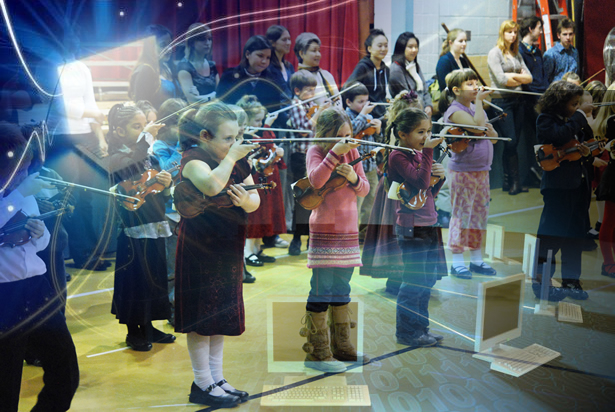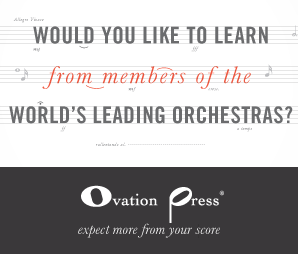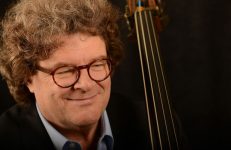
Last month I had the opportunity to participate in a live roundtable discussion hosted by ArtistWorks and broadcast online. For those of you who aren’t familiar with it, ArtistWorks is an online initiative for music education where students and teachers engage in a video exchange to facilitate the learning normally done in live lessons. We had previously shared their press release over our Twitter channel:
Starting today, music students from around the world are able to take classical music lessons one-on-one online with world-renowned artists at the first-ever online campus for classical music lessons. The ArtistWorks Classical Music Campus features online music schools in four core orchestral instruments that include flute, trumpet, clarinet, and French horn, with violin following later in the Fall. Also included in the Classical Campus are current ArtistWorks classical piano and classical guitar schools.
Instructors at the ArtistWorks Classical Campus include Jeffrey Khaner (Principal Flutist, Philadelphia Orchestra, Curtis Institute); David Bilger (Principal Trumpet, Philadelphia Orchestra, Curtis Institute, University of Georgia, Temple University); Ricardo Morales (Principal Clarinetist, Philadelphia Orchestra, Curtis Institute, Juilliard, Temple University); Bill Caballero (Principal French Horn, Pittsburgh Orchestra, Carnegie Mellon University School of Music); Nathan Cole (First Associate Concertmaster, Los Angeles Philharmonic); as well as guitarist Jason Vieaux (Curtis Institute, Cleveland Institute of Music) and pianist Christie Peery (Peabody Institute).
The Classical Music Campus teaching artists are all principal performers within their respective orchestras and in addition, most are music instructors at various ultra exclusive classical music schools including Juilliard, Curtis Institute and the Carnegie Mellon University School of Music. Previously, direct access to these prestigious teaching artists was reserved for only the most elite students in the world.
This will be the first part in a short series examining the future of classical music education and how technology is playing a role in the evolution of modern and alternative educational formats.
This series is not an official sponsorship of ArtistWorks. Ovation Press is in no way affiliated with ArtistWorks and will not be compensated for anyone who decides to sign-up for the services they provide after reading these articles on String Visions. Though ArtistWorks will be a major focus during this series, its selection as such does not constitute an endorsement. It was chosen to serve as an example and illustrate a unique and (so far) successful model of online music education.
When I first read about ArtistWorks, the idea was certainly intriguing to me. I wanted to know more about ArtistWorks. When they announced that they would be doing a live roundtable I made it a point to be available for at least a portion of it. Ironically, they were plagued with some technical issues at the beginning, but for the most part everything ran quite smoothly.
Initially I was quite skeptical of such a service, but after listening to several of the speakers I was surprised by how persuaded I had become.
The core of ArtistWorks revolves around several key points:
- The best teachers and instructors usually are not available to very many people
- As a result, they are somewhat limited in terms of how many students they can reach on an individual basis
- Consequently, many students are unable to benefit from the expertise and knowledge of these teachers
- Thus, ArtistWorks’ mission becomes to harness technology to fill this void, providing regular and affordable access for these students to these teachers
ArtistWorks CEO David Butler, himself a technology professional who previously worked at AOL, asked a very poignant question: “where do you see technology impacting classical music?”
The first thing that comes to mind for most people is YouTube. Sure enough, one of the roundtable participants touched on this very issue:
Everybody I teach is on YouTube. They come to me and say “I saw this or that on the site; do you recommend that fingering or that tempo.” This phenomenon is here to stay. The access is great, and there is a lot of quantity.
But what about quality? Exactly Who is posting these videos? The challenge is to help students realize that just because something is up there on the web, doesn’t mean it’s something you should emulate.
As a music teacher, you’ve no doubt encountered this already. Someone comes to a lesson and plays something a certain way… and when you ask them if & where they saw someone do that, they say “on YouTube.”
In more recent times we’ve seen the combination of YouTube and Google in the latter’s social network Google+, which has created breakout artists such as Daria Musk. Orchestras, small ensembles, non-profits, and even individual artists have attempted to use this and other social media sites like Facebook and Twitter to generate online buzz, traffic, and exposure to classical music.
Another (perhaps more practical) example that comes to mind is web conferencing technology such as Skype, which enables teacher and student to have a lesson across great distances. This has become increasingly popular in recent years. Our very own co-founder Hans Jensen has taught several regular students this way.
Yet, this wondrous technology is not without significant drawbacks. Virtual lessons are completely at the mercy of the technology limitations: slow Internet connection, bad audio quality, etc. Professional-grade setups for web conferencing can easily reach into the thousands and tens of thousands of dollars, putting this availability beyond the reach of most people… especially starving artists.
We often talk about the Internet as a force that democratizes, that equalizes opportunity and access. However, access to online music education, beyond watching and emulating videos (which many question as “education”) still seems to be lagging beyond the incredible technology available to us today.
How do we take the next step?
In subsequent articles we will explore more about ArtistWorks and what has been successful in it as a program. From there we will explore what that could mean for the future of online music education.
Additional Resources
Comprehensive review of ArtistWorks on Beginner Guitar HQ.














[url=http://www.ooobag.com/watch/franckmuller/tonneau/6df2d4b8c64fb4c0.html]2009オメガ观澜湖ゴルフワールドカップは中国观澜湖ゴルフ会で盛大に開幕。 オメガスーパーコピー未来は4日、28チームはギネス記録世界1球が激しい試合、ゴルフに重みを最も重い1基のトロフィー。[/url]
[url=http://www.bestevance.com/rolex/gmt/index.htm]12ヶ月前、アカザのコーニングはメルボルン運転フェラーリ初もぎ取る大会冠。ウブロスーパーコピー今年から見れば、オーストラリアの全体の2008フォーミュラ1シーズンは、4位のタグホイヤー大使得意満面にかけているタグホイヤーの代表。[/url]
[url=http://www.bestevance.com/cartier/solo/]ロレックススーパーコピー がリリースしたポルトガル年間カレンダーの新しい動きと有用な合併症にもかかわらず、誰でも喜ばせませんでした。はい、多くの人々は、iwcのポルトガル年間カレンダーが好きでした、しかし、多くの不満を時計のサイズが大きすぎると、それは非常に高価であった。[/url]
j http://tadalafil-ph24.com/ cialis buy cheap
100%品質保証!満足保障!
商品数も大幅に増え、品質も大自信です
ブランドバッグ スーパーコピー,スーパーコピーブランド販売
最高品質のアイテムアウトレットクリアランス販売
品質がよい 価格が低い 実物写真 品質を重視
ご注文を期待しています!
オメガスーパーコピー
スーパーコピー時計ブランドコピー財布専門店
ルイ・ヴィトン | エルメス | グッチ |
プラダ| セリーヌ | ゴヤール|エルメス特集 | ブランド館(拜购)
ルイ・ヴィトン | エルメス | ゴヤール|ジュエリー・アクセサリー | 靴
主要取扱商品 バッグ、財布、腕時計、靴、装飾品、小物等!
プロのブランドコピーの専門家,スーパーコピーの先駆者、国内で最高に成熟したブランドコピー専門店。
スイスのチップ適用、実物写真、実物が写真および描写と一致、公式サイトの外観、規格、機能と一致。
シャネルバッグコピー品
i like this, enjoyed article
Thanks for information
IT Telkom
Thank You !
http://www.iaees.org/publications/journals/ces/downloads.asp?article=2012-2-3-1dale&url=https://bcaf.telkomuniversity.ac.id